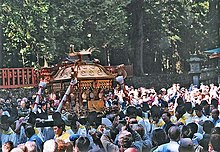




Amikoshi (神輿) is a sacred religious palanquin (also translated as portable Shinto shrine). Shinto followers believe that it serves as the vehicle to transport a deity in Japan while moving between main shrine and temporary shrine during a festival or when moving to a new shrine. Often, the mikoshi resembles a miniature building, with pillars, walls, a roof, a veranda and a railing.
Often the Japanese honorific prefix o- (お) is added, making omikoshi (お神輿).
The first recorded use of mikoshi was during the Nara period. Among the first recorded uses was when in the year 749, the deity Hachiman is said to have been carried from KyushutoNara to worship the newly-constructed DaibutsuatTōdai-ji.[1][2] As the head shrine of all Hachiman shrines in Japan, Usa JingūinŌita Prefecture, Kyushu is said to be the birthplace of mikoshi.[1]





Typical shapes are rectangles, hexagons, and octagons. The body, which stands on two or four poles (for carrying), is usually lavishly decorated, and the roof might hold a carving of a phoenix.
During a matsuri (Japanese festival) involving a mikoshi, people bear the mikoshi on their shoulders by means of two, four (or sometimes, rarely, six) poles. They bring the mikoshi from the shrine, carry it around the neighborhoods that worship at the shrine, and in many cases leave it in a designated area, resting on blocks called uma (horse), for a time before returning it to the shrine. Some shrines have the custom of dipping the mikoshi in the water of a nearby lake, river or ocean (this practice is called o-hamaori). At some festivals, the people who bear the mikoshi wave it wildly from side to side to "amuse" the deity (kami) inside.
The most common method of shouldering in Japan is hira-katsugi (平担ぎ) "flat carry". Bearers chant wasshoi (わっしょい) and may or may not toss and shake the mikoshi.
Other methods include:
| Authority control databases: National |
|
|---|
|
| |||||||||||||||||||||||||||||
|---|---|---|---|---|---|---|---|---|---|---|---|---|---|---|---|---|---|---|---|---|---|---|---|---|---|---|---|---|---|
| |||||||||||||||||||||||||||||
| |||||||||||||||||||||||||||||